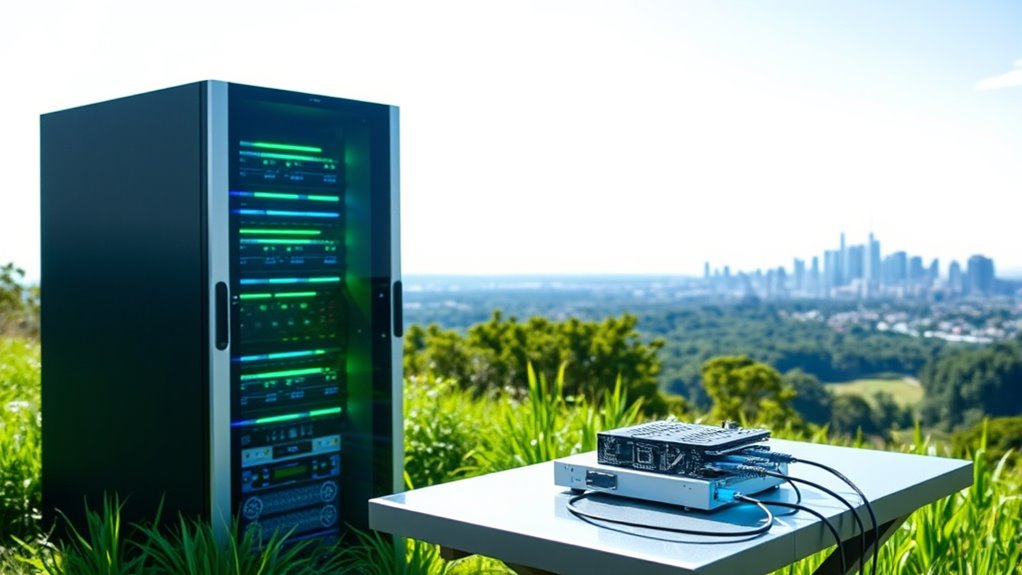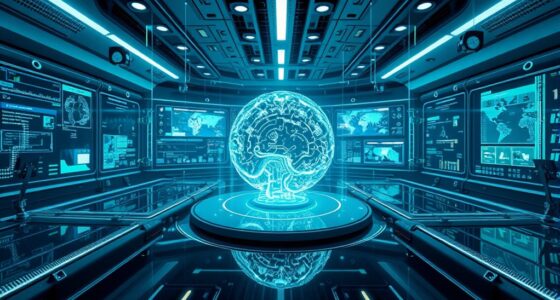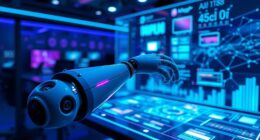Hybrid edge-cloud AI balances latency and compute needs by handling time-sensitive tasks directly on local devices, reducing response time, while outsourcing complex processing to the cloud for heavy workloads. This approach guarantees quick decision-making for applications like security and autonomous vehicles, without sacrificing accuracy or security. By intelligently distributing tasks, it optimizes resource use and minimizes data transfer. To discover how this seamless balance improves performance, continue exploring the key strategies behind hybrid AI systems.
Key Takeaways
- Hybrid AI distributes processing tasks between edge devices for low latency and cloud servers for heavy computation.
- Local edge processing ensures real-time responses while minimizing data transmission to the cloud.
- Cloud resources handle complex analytics, deep learning, and large-scale data storage, offloading from edge devices.
- Transmitting only relevant summaries or data reduces bandwidth, network congestion, and costs.
- This balance enhances security, compliance, and scalability, optimizing overall system efficiency.

Have you ever wondered how AI applications deliver real-time insights without sacrificing accuracy or security? The secret lies in the innovative approach known as hybrid edge-cloud AI. This technology combines the strengths of both edge computing and cloud computing to optimize performance, minimize latency, and guarantee data security. Instead of relying solely on centralized cloud servers or distant data centers, hybrid edge-cloud AI distributes processing tasks across local devices and cloud infrastructure. This balance allows you to get immediate responses when needed, while still leveraging the vast computing power of the cloud for more intensive tasks.
Hybrid edge-cloud AI combines local processing and cloud power for faster, secure insights.
When you use edge devices—like smartphones, sensors, or IoT gadgets—they handle initial data processing close to the source. This means your AI applications can analyze data on-site, reducing the time it takes to generate insights. For example, a smart security camera can detect motion and recognize faces instantly without needing to send every frame to a remote server. This setup minimizes latency, so your system reacts swiftly, which is essential for applications that demand real-time responses, such as autonomous vehicles or industrial automation. Plus, processing data locally keeps sensitive information within the device or local network, enhancing security and privacy.
However, edge devices have limited computing resources compared to the cloud. When tasks become too complex or data volumes increase, the system intelligently offloads processing to the cloud. The cloud provides the heavy-duty computation, large storage capacity, and advanced analytics needed for deep learning models, trend analysis, or large-scale data aggregation. This division ensures you’re not constrained by the limitations of edge hardware, and the system remains scalable and adaptable to evolving demands.
The key advantage of hybrid AI is its flexibility. You can design workflows where critical, time-sensitive operations happen at the edge, guaranteeing immediate action, while less urgent or data-intensive tasks are handled centrally. This setup reduces bandwidth requirements because only relevant data or summaries are transmitted to the cloud, easing network congestion and lowering costs. It also enhances security because sensitive information can be processed locally and kept within trusted environments, minimizing exposure during transmission.
In addition, hybrid edge-cloud AI can facilitate compliance with data sovereignty regulations by keeping sensitive data within specific jurisdictions, which is increasingly important in global deployment scenarios. In essence, hybrid edge-cloud AI provides a seamless, efficient way to meet both your need for rapid, accurate insights and the demands of secure, scalable computing. It allows you to optimize resources, improve response times, and safeguard data—all while maintaining the high performance and flexibility that modern AI applications require.
Frequently Asked Questions
How Does Hybrid AI Impact Data Privacy and Security?
Hybrid AI enhances data privacy and security by keeping sensitive information local at the edge, reducing exposure during transmission. You control where data is processed, minimizing risks of breaches. Cloud components handle less sensitive tasks, and encryption secures data across the system. This setup helps you maintain compliance and protect user information while balancing performance needs, giving you greater confidence in your AI deployment’s security.
What Industries Benefit Most From Hybrid Edge-Cloud AI?
You’ll find the healthcare, manufacturing, and retail industries benefit most from hybrid edge-cloud AI. In healthcare, it helps process sensitive patient data securely while providing quick diagnostics. Manufacturing companies use it to monitor equipment in real-time, reducing downtime. Retailers leverage it for personalized shopping experiences without risking customer privacy. By balancing local processing and cloud capabilities, these industries improve efficiency, security, and customer satisfaction, making hybrid AI a game-changer for their operations.
How Is Cost Management Handled in Hybrid AI Deployments?
You manage costs in hybrid AI deployments by carefully distributing workloads between the edge and cloud to optimize expenses. You monitor resource usage regularly, adjust the deployment dynamically, and prioritize critical tasks for edge processing to reduce cloud fees. Additionally, you leverage automation and cost analytics tools to identify inefficiencies, control data transfer costs, and guarantee you’re getting the best value from your infrastructure investments.
What Are the Scalability Challenges of Hybrid AI Systems?
You might face scalability challenges in hybrid AI systems as your workload grows. Managing data transfer between edge devices and the cloud can cause latency issues, while upgrading infrastructure requires significant investment. Ensuring consistent performance across distributed components is complex, and balancing compute resources becomes harder as demand fluctuates. You need flexible, scalable solutions that adapt seamlessly, but orchestrating this balance often demands sophisticated planning and resource management.
How Do Hybrid AI Solutions Adapt to Evolving Technology Standards?
Imagine a chameleon changing colors to blend into new surroundings; that’s how hybrid AI solutions adapt to evolving tech standards. You update algorithms, integrate new protocols, and optimize hardware seamlessly, ensuring your system stays current. By designing modular components and embracing flexible architectures, you enable your AI to evolve alongside industry innovations. This proactive approach keeps your AI efficient, reliable, and ready for future challenges, much like a chameleon thriving in diverse environments.
Conclusion
Imagine you’re managing a busy restaurant; you keep fresh ingredients on-site for quick prep but rely on cloud deliveries for specialty items. Similarly, hybrid edge-cloud AI balances immediate responses with powerful processing. Just like your kitchen, this approach guarantees you serve fast without sacrificing quality. By optimizing where tasks are handled, you meet both latency needs and compute demands—delivering a seamless experience that feels as effortless as a well-run restaurant on a busy night.









